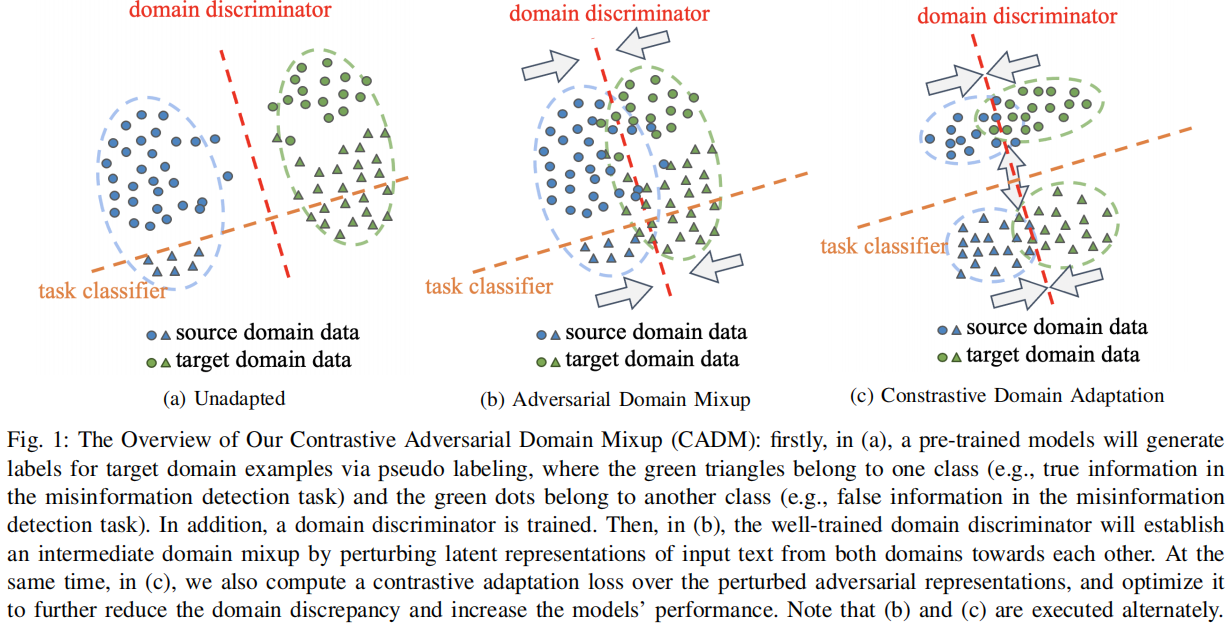虚假新闻检测(CADM)《Unsupervised Domain Adaptation for COVID-19 Information Service with Contrastive Adversarial Domain Mixup》
论文信息
论文标题:Unsupervised Domain Adaptation for COVID-19 Information Service with Contrastive Adversarial Domain Mixup
论文作者:Huimin Zeng, Zhenrui Yue, Ziyi Kou, Lanyu Shang, Yang Zhang, Dong Wang
论文来源:aRxiv 2022
论文地址:download
论文代码:download
1 Introduction
2 Problem Statement
Regarding misinformation detection, we aim at training a model $f$ , which takes an input text $\boldsymbol{x}$ (a COVID-19 claim or a piece of news) to predict whether the information contained in $\boldsymbol{x}$ is valid or not (i.e., a binary classification task). Moreover, in our domain adaptation problem, we use $\mathcal{P}$ to denote source domain data distribution and $\mathcal{Q}$ for the target domain data distribution. Each data point ($\boldsymbol{x}$, $y$) contains an input segment of COVID-19 claim or news ($\boldsymbol{x}$) and a label $y \in\{0,1\}$ ( $y=1$ for true information and $y=0$ for false information). To differentiate the notations of the data sampled from the source distribution $\mathcal{P}$ and the target distribution $\mathcal{Q}$ , we further introduce two definitions of the domain data:
- Source domain: The subscript $s$ is used to denote the source domain data: $\mathcal{X}_{s}=\left\{\left(\boldsymbol{x}_{s}, y_{s}\right) \mid\left(\boldsymbol{x}_{s}, y_{s}\right) \sim \mathcal{P}\right\}$ .
- Target domain: Similarly, the subscript t is used to denote the target domain data: $\mathcal{X}_{t}=\left\{\boldsymbol{x}_{t} \mid \boldsymbol{x}_{t} \sim \mathcal{P}\right\}$ . Note that in our unsupervised setting, the ground truth labels of target domain data $y_{t}$ are not used during training.
Our goal is to adapt a classifier $f$ trained on $\mathcal{P}$ to $\mathcal{Q}$ . For a given target domain input $\boldsymbol{x}_{t}$ , a well-adapted model aims at making predictions as correctly as possible.
3 Method
整体框架:

3.1 Domain Discriminator
第一步是训练一个域鉴别器 $f_{D}$ 来分类输入数据是属于源域还是属于目标域。该域鉴别器与 COVID 模型共享相同的 BERT Encoder $f_{e}$,并具有不同的二进制分类模块 $f_{D}$。域鉴别器以 BERT Encoder 中的标记 [CLS] 表示作为输入,以预测输入数据的域,如所示:
$\hat{y}=f_{D}(\boldsymbol{z}) \quad\quad(1)$
其中,$z$ 是 token [CLS] 的表示。
对于 $f_{D}$ 的训练,明确地将源域数据的域标签 $y_{D}$ 定义为 $y_{D}=0$,将目标域数据的域标签定义为 $y_{D}=1$。因此,对域鉴别器的训练可以表述为:
$\underset{f_{D}}{\text{min}} \;\; \mathbb{E}_{\left(\boldsymbol{x}, y_{D}\right) \sim \mathcal{X}^{\prime}}\left[l\left(f_{D}\left(f_{e}(\boldsymbol{x})\right), y_{D}\right)\right] \quad\quad(2)$
其中,$\mathcal{X}^{\prime}$ 表示带有域标签的源域和目标域训练数据的合并数据集。
3.2 Adversarial Domain Mixup
在训练了域鉴别器后,我们提出直接干扰来自源域和目标域的输入数据的潜在表示到域鉴别器的决策边界,如 Figure 1b 所示。为此,来自两个域的扰动表示(即域对抗表示)可以变得更接近,表明域间隙减小。在此,从两个域生成的域对抗性表示在模型的潜在特征空间中形成了一个平滑的中间域混合。在数学上,通过求解一个优化问题,可以找到干扰训练样本 $ \boldsymbol{x}$ 的潜在表示 $ \boldsymbol{z}$ 的最优扰动 $\delta^{*}$:
$\begin{array}{r}\mathcal{A}\left(f_{e}, f_{D}, \boldsymbol{x}, y_{D}, \epsilon\right)=\underset{\boldsymbol{\delta}}{\text{max}} \left[l\left(f_{D}(\boldsymbol{z}+\boldsymbol{\delta}), y_{D}\right)\right] \\\text { s.t. } \quad\|\boldsymbol{\delta}\| \leq \epsilon, \quad \boldsymbol{z}=f_{e}(\boldsymbol{x})\end{array}\quad\quad(3)$
注意,在上面的方程中,我们引入了一个超参数 $\epsilon$ 来约束扰动 $\delta$ 的范数,从而避免了无穷大解。最后,将 $\text{Eq.3}$ 应用于合并训练集 $\mathcal{X}^{\prime}$ 中的所有训练样本,得到对抗域混合 $\mathcal{Z}^{\prime}$:
$\begin{aligned}\mathcal{Z}^{\prime} & =\left\{\boldsymbol{z}^{\prime} \mid \boldsymbol{z}^{\prime}=\boldsymbol{z}+\mathcal{A}\left(f_{e}, f_{D}, \boldsymbol{x}, y_{D}, \epsilon\right),\left(\boldsymbol{x}, y_{D}\right) \in \mathcal{X}^{\prime}\right\} \\& :=\mathcal{Z}_{s}^{\prime} \cup \mathcal{Z}_{t}^{\prime}\end{aligned}\quad\quad(4)$
其中,$\mathcal{Z}_{s}^{\prime}$ 是扰动的源特性,$\mathcal{Z}_{t}^{\prime}$ 是受干扰的目标特征。我们使用投影梯度下降(PGD)来近似 $\text{Eq.3}$ 的解,如在[7],[8]。
3.3 Contrastive Domain Adaptation
接下来,受[6]的启发,我们提出了 $\mathcal{Z}_{a d v}$ 的双重对比自适应损失,以进一步将源数据域的知识适应到目标数据域。首先,我们减少了类内表示之间的域差异。也就是说,如果一个表示从源数据域的标签是真(或假)和一个表示从目标数据域的伪标签是真(或假),那么这两个表示被视为类内表示,我们减少域之间的差异。其次,如 Figure 1c 所示,真实信息和虚假信息的表示之间的差异将被扩大。
为了计算我们提出的对比自适应损失,我们建议使用径向基函数(RBF)来度量标记类之间的差异。在[11]中,RBF 被证明是量化深度神经网络中不确定性的有效工具。由于我们的伪标记过程是为了自动过滤出目标域数据的低置信度标签,因此使用RBF来衡量标记类之间的差异可以有效地提高伪标签的质量,最终有助于模型的域适应。
在形式上,使用 RBF 内核的定义:$k\left(z_{1}, z_{2}\right)=\exp \left[-\frac{\left\|\boldsymbol{z}_{1}-\boldsymbol{z}_{2}\right\|^{2}}{2 \sigma^{2}}\right]$
我们定义了错误信息检测任务的类感知损失如下:
$\begin{aligned}\mathcal{L}_{\text {con }}\left(\mathcal{Z}^{\prime}\right) =&-\sum_{i=1}^{\left|\mathcal{Z}_{s}^{\prime}\right|} \sum_{j=1}^{\left|\mathcal{Z}_{t}^{\prime}\right|} \frac{\mathbb{1}\left(y_{s}^{(i)}=0, \hat{y}_{t}^{(j)}=0\right) k\left(\boldsymbol{z}_{s}^{(i)}, \boldsymbol{z}_{t}^{(j)}\right)}{\sum_{l=1}^{\left|\mathcal{Z}_{s}^{\prime}\right|} \sum_{m=1}^{\left|\mathcal{Z}_{t}^{\prime}\right|} \mathbb{1}\left(y_{s}^{(l)}=0, \hat{y}_{t}^{(m)}=0\right)} \\& -\sum_{i=1}^{\left|\mathcal{Z}_{s}^{\prime}\right|} \sum_{j=1}^{\left|\mathcal{Z}_{t}^{\prime}\right|} \frac{\mathbb{1}\left(y_{s}^{(i)}=1, \hat{y}_{t}^{(j)}=1\right) k\left(\boldsymbol{z}_{s}^{(i)}, \boldsymbol{z}_{t}^{(j)}\right)}{\sum_{l=1}^{\left|\mathcal{Z}_{s}^{\prime}\right|} \sum_{m=1}^{\left|\mathcal{Z}_{t}^{\prime}\right|} \mathbb{1}\left(y_{s}^{(l)}=1, \hat{y}_{t}^{(m)}=1\right)} \\& +\sum_{i=1}^{\left|\mathcal{Z}_{s}^{\prime}\right|} \sum_{j=1}^{\left|\mathcal{Z}_{s}^{\prime}\right|} \frac{\mathbb{1}\left(y_{s}^{(i)}=1, y_{s}^{(j)}=0\right) k\left(\boldsymbol{z}_{s}^{(i)}, \boldsymbol{z}_{s}^{(j)}\right)}{\sum_{l=1}^{\left|\mathcal{Z}_{s}^{\prime}\right|} \sum_{m=1}^{\left|\mathcal{Z}_{s}^{\prime}\right|} \mathbb{1}\left(y_{s}^{(l)}=1, y_{s}^{(m)}=0\right)} \\& +\sum_{i=1}^{\left|\mathcal{Z}_{t}^{\prime}\right|} \sum_{j=1}^{\left|\mathcal{Z}_{t}^{\prime}\right|} \frac{\mathbb{1}\left(\hat{y}_{t}^{(i)}=1, \hat{y}_{t}^{(j)}=0\right) k\left(\boldsymbol{z}_{t}^{(i)}, \boldsymbol{z}_{t}^{(j)}\right)}{\sum_{l=1}^{\left|\mathcal{Z}_{t}^{\prime}\right|} \sum_{m=1}^{\left|\mathcal{Z}_{t}^{\prime}\right|} \mathbb{1}\left(\hat{y}_{t}^{(l)}=1, \hat{y}_{t}^{(m)}=0\right)}\end{aligned}\quad\quad(5)$
其中,$\hat{y}_{t}$ 为目标域样本的伪标签,$z$ 表示标记 CLS 的表示。
3.4 Overall Contrastive Adaptation Loss
现在,我们将任务分类问题的交叉熵损失和上述对比自适应损失合并为 COVID 模型的单一优化目标:
$\mathcal{L}_{\text {all }}=\mathcal{L}_{c e}(\boldsymbol{\mathcal { X }})+\lambda \mathcal{L}_{\text {con }}\left(\mathcal{Z}^{\prime}\right) \quad\quad(6)$
其中,$\mathcal{L}_{c e}$ 代表交叉熵损失函数。
4 Experiment
在我们的实验中,我们使用了三个 source misinformation datasets :GossipCop , LIAR and PHEME,两个 COVID misinformation datasets:Constraint and ANTiVax。
Results:

虚假新闻检测(CADM)《Unsupervised Domain Adaptation for COVID-19 Information Service with Contrastive Adversarial Domain Mixup》的更多相关文章
- Domain Adaptation (3)论文翻译
Abstract The recent success of deep neural networks relies on massive amounts of labeled data. For a ...
- Unsupervised Domain Adaptation by Backpropagation
目录 概 主要内容 代码 Ganin Y. and Lempitsky V. Unsupervised Domain Adaptation by Backpropagation. ICML 2015. ...
- Deep Transfer Network: Unsupervised Domain Adaptation
转自:http://blog.csdn.net/mao_xiao_feng/article/details/54426101 一.Domain adaptation 在开始介绍之前,首先我们需要知道D ...
- 论文阅读 | A Curriculum Domain Adaptation Approach to the Semantic Segmentation of Urban Scenes
paper链接:https://arxiv.org/pdf/1812.09953.pdf code链接:https://github.com/YangZhang4065/AdaptationSeg 摘 ...
- Domain Adaptation (1)选题讲解
1 所选论文 论文题目: <Unsupervised Domain Adaptation with Residual Transfer Networks> 论文信息: NIPS2016, ...
- A Primer on Domain Adaptation Theory and Applications
目录 概 主要内容 符号说明 Prior shift Covariate shift KMM Concept shift Subspace mapping Wasserstein distance 应 ...
- 关于模式识别中的domain generalization 和 domain adaptation
今晚听了李文博士的报告"Domain Generalization and Adaptation using Low-Rank Examplar Classifiers",讲的很精 ...
- 【论文笔记】Domain Adaptation via Transfer Component Analysis
论文题目:<Domain Adaptation via Transfer Component Analysis> 论文作者:Sinno Jialin Pan, Ivor W. Tsang, ...
- 域适应(Domain adaptation)
定义 在迁移学习中, 当源域和目标的数据分布不同 ,但两个任务相同时,这种 特殊 的迁移学习 叫做域适应 (Domain Adaptation). Domain adaptation有哪些实现手段呢? ...
- Domain Adaptation论文笔记
领域自适应问题一般有两个域,一个是源域,一个是目标域,领域自适应可利用来自源域的带标签的数据(源域中有大量带标签的数据)来帮助学习目标域中的网络参数(目标域中很少甚至没有带标签的数据).领域自适应如今 ...
随机推荐
- Oh My Life~
作者:HChan 链接:https://zhuanlan.zhihu.com/p/47084162 来源:知乎 著作权归作者所有.商业转载请联系作者获得授权,非商业转载请注明出处. Part 1 那年 ...
- java:找不到符号
出现这种情况的原因之一:实体类的字段修改过.实体类中的变量名修改.然而其他地方调用的字段名还是修改之前的变量.
- 42.JSON Web Token认证
JSON Web Token认证介绍 简称JWT认证,一般用于用户认证 JWT是一种相当新的标准,可用于基于token的身份验证 与内置的TokenAuthentication方案不同,JWT不需要使 ...
- vuex和浏览器【sessionStorage,localStorage ..】 得区别
1.Vuex的主要作用是用来共享和管理数据,那为什么不直接使用浏览器缓存呢?2.Vuex和浏览器缓存策略的根本区别是什么?3.Vuex,state仓库中的数据流是单向同步的,那为什么可以在action ...
- 加速乐逆向 cookies 参数
简介 加速乐用于解决网站访问速度过慢及网站反黑客问题. 爬取使用该技术网站时需要携带特定的cookies参数(有的是__jsl_clearance_s,有的__jsl_clearance),本项目以一 ...
- BI系统打包Docker镜像及部署的技术难度和实现
BI系统打包Docker镜像及部署的技术难度和实现 随着容器化技术盛行,Docker在前端领域也有着越来越广泛的应用:传统的前端部署方式需要我们将项目打包生成一系列的静态文件,然后上传到服务器,配置n ...
- linux系统启动达梦迁移工具失败解决办法
在达梦数据库服务端的tool目录下执行./dts来启动迁移工具,迁移工具启动前出现报错,以下提供几种遇到问题的解决办法: 1. 报错1: 执行./dts,报错提示: [yyuser@qy-ggyf-z ...
- Codeforces Round #786 (Div. 3) 补题记录
小结: A,B,F 切,C 没写 1ll 对照样例才发现,E,G 对照样例过,D 对照样例+看了其他人代码(主要急于看后面的题,能调出来的但偷懒了. CF1674A Number Transforma ...
- day02-实现01
实现01 1.实现任务阶段1 编写mytomcat,该服务器能给浏览器返回"你好,我是服务器!"的简单信息. 根据之前的tomcat框架整体分析,我们将浏览器发送请求,tomcat ...
- 链表实现-回文palindrome判断
1.数字回文判断(逆转,分离未位,砍掉个位,保存原来) s = s * 10 + a%10 a = a/10 2.字符串判断回文 package main //思路: 开发一个栈来来存放链表的上半段f ...
